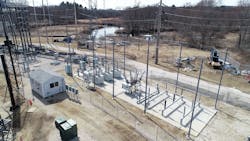Industry Challenge
Rapid and repeatable information on the long-term performance of emerging substation sensor technologies and substation apparatus under realistic operating scenarios is needed prior to widescale deployment. But often, this information is learned from deployment in utility substations, which is expensive, can carry higher risk, and might provide limited information.
EPRI’s Response
A full-scale, three-phase, outdoor energized 138-kV substation has been designed, constructed, and commissioned at the Electric Power Research Institute’s (EPRI’s) High-Voltage Laboratory in Lenox, Massachusetts. The research substation has all the key components of a utility substation — transformer bushings, an SF6 circuit breaker, a disconnect, buswork, arresters, post insulators, and composite poles. The substation allows rapid and cost-effective knowledge gathering on how new substation components (such as new, oil-free bushings) perform over time and how on-line monitoring technologies (such as on-line bushing monitoring and on-line partial discharge detection) respond to a wide range of repeatable and realistic scenarios. The Lenox location is ideal because the assets will experience cold winters with ice and snow, warm springs, and summers with fog from the adjacent river. A spray system has also been installed to increase the wetting rate.
Progress, Results & Next Steps
The substation is now operational, with the transformer bushings both energized and subjected to high current. This current injection is achieved by each phase having two bushings installed in a tank, with both the top and bottom connected to form a loop. The bushing current transformers are backfed to inject up to rated current (800 A). This allows for a deeper understanding of how bushing and on-line monitors operate and age under varying currents and real-world conditions.
How to Use the Research
The benefits of the full-scale 138-kV research substation are as follows:
On-line monitor evaluation (EPRI sensors and original equipment manufacturers’ devices) results will guide utility specifications.
- Aging tests on new substation apparatus.
- Aging of novel icephobic and superhydrophobic coatings for insulators and conductors.
- Surge arrester aging and on-line monitor evaluation.
- Ground grid evaluation – The substation ground grid can be adjusted to evaluate the performance of ground grid monitors.
- Composite structure research – Different makes and models of composite structures are installed and are undergoing aging and stress testing.
The research laboratory allows repeatable data to be generated rapidly against well-defined test protocols.
How to Get Involved
In collaboration with member utilities, EPRI has already developed and started to execute test protocols for a wide range of studies. To get directly involved, utilities can contact Luke van der Zel ([email protected]) and discuss their specific needs. EPRI’s role is to take that input and use it to develop and execute collaborative research projects to address industry needs. The new 138-kV research substation provides a powerful tool in producing rapid results that the industry can immediately apply.
About the Author
Luke Van der Zel
Luke Van der Zel is a technical lead for EPRI’s T&D RF Sensor Toolbox development and applications.

